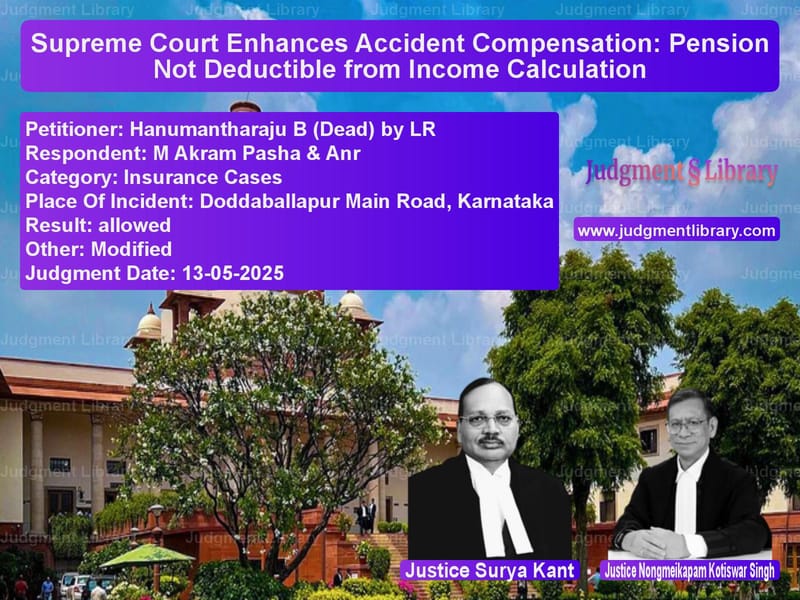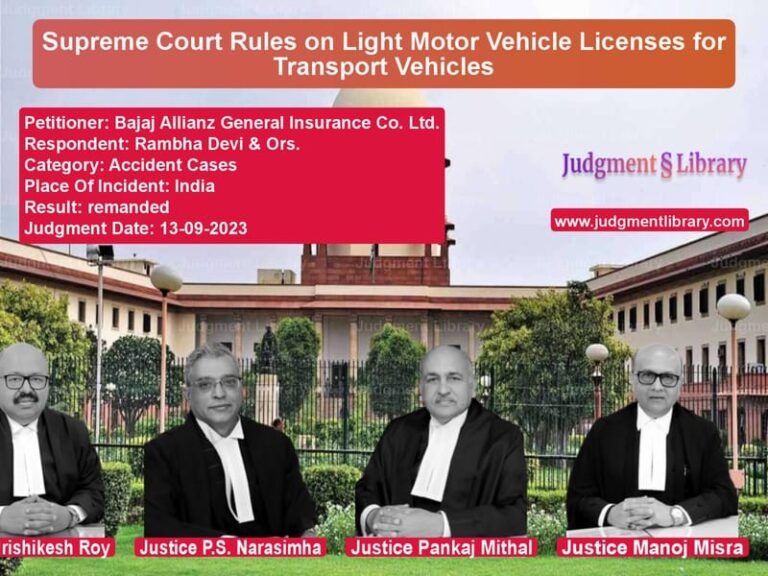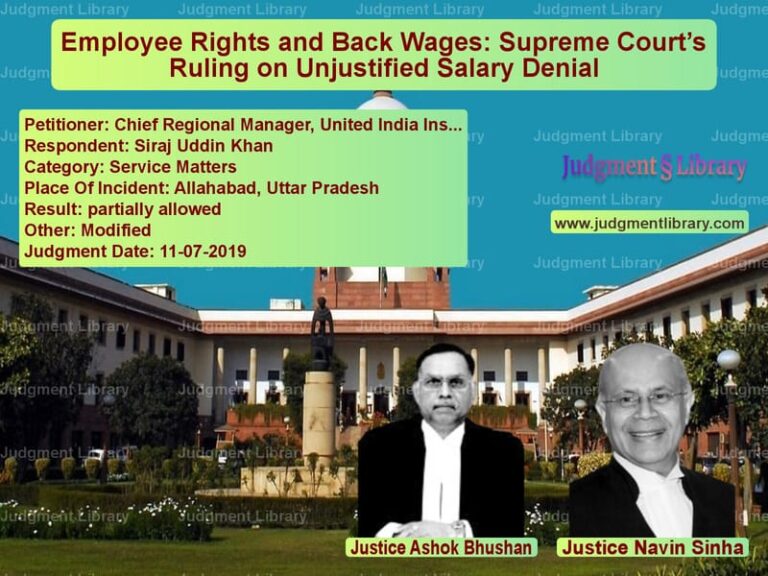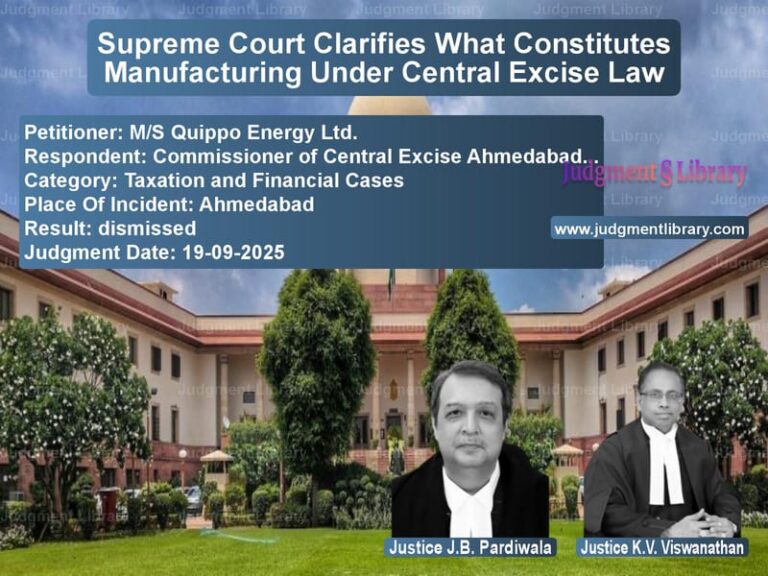Supreme Court Enhances Accident Compensation: Pension Not Deductible from Income Calculation
In a significant ruling that brings relief to accident victims and their families, the Supreme Court of India has delivered a comprehensive judgment addressing several crucial aspects of compensation calculation in motor accident claims. The case involving Hanumantharaju B, a CRPF Sub-Inspector who suffered life-altering injuries in a road accident, has set important precedents regarding how courts should compute compensation, particularly concerning pension benefits, future prospects, and disability assessment. The judgment, delivered on May 13, 2025, by a bench comprising Justice Surya Kant and Justice Nongmeikapam Kotiswar Singh, not only provides substantial financial relief to the appellant but also clarifies several legal principles that will guide future accident claim cases across the country.
The Tragic Accident and Its Consequences
The case originated from a unfortunate incident on May 10, 2010, when Hanumantharaju B, who was working as a Sub-Inspector in the office of DIGP, CRPF, Yelahanka Base, Bangalore, was driving his motorcycle to Yelahanka on Doddaballapur Main Road, Karnataka. At approximately 1:45 pm, when he reached J. Valsal Road, CRPF Campus, an Omni Car bearing registration KA-04/C-826 owned by Respondent No. 1 took a sudden right turn, resulting in a collision with Hanumantharaju’s motorcycle. The impact was severe, causing him to fall and sustain grievous injuries. The same day, FIR No. 86/2010 was lodged against the car driver under Sections 279 and 337 of the Indian Penal Code at Yelahanka Police Station.
The medical records revealed the seriousness of his condition – he was admitted to the hospital on three different occasions for nearly 15 days immediately after the accident and underwent surgery on his left leg. The injuries were so severe that he also suffered a heart attack due to stress and the physical trauma. A Medical Board constituted at the Composite Hospital, Bengaluru examined his physical fitness and certified him to be suffering from physical disabilities at 61.94%. This disability made it impossible for him to perform his duties properly, and he didn’t receive due promotions. Ultimately, he was discharged from service on March 22, 2012, cutting short what could have been a promising career in the paramilitary forces.
The Legal Journey Through Various Courts
Prior to his discharge from service, Hanumantharaju filed Motor Accident Claim MVC No. 5024/2010 on August 5, 2010, claiming compensation of Rs. 74 lakhs from the respondents. The Motor Accident Claims Tribunal (MACT), Bangalore, in its order dated January 31, 2014, awarded him Rs. 3,28,422 along with 9% interest per annum. The Tribunal considered his last drawn salary of Rs. 36,231 at the time of the accident and the disability assessed at 61.94% by the Medical Board.
Dissatisfied with this amount, Hanumantharaju preferred an appeal before the Karnataka High Court, seeking enhancement of compensation. Both parties agreed that the matter required reconsideration by the Tribunal. Accordingly, the High Court, without expressing any opinion on the merits, remanded the matter to the Tribunal for fresh consideration on January 12, 2015.
When the matter went back to the MACT, the Tribunal appointed a Commissioner, Dr. Shankar R. Krupad, who had treated Hanumantharaju at Columbia Asia Referral Hospital. Dr. Krupad assessed the total disability at 77.72%, significantly higher than the Medical Board’s assessment of 61.94%. Despite this, the Tribunal, citing lack of material to show whether the appellant was completely incapacitated or doing any job post-retirement, arbitrarily reduced the disability to 50%, holding that it would ‘meet the ends of justice.’ The Tribunal also deducted income tax and professional tax from his salary, assessing monthly income at Rs. 33,761. After applying 50% disability to this figure, it computed monthly loss of earning at Rs. 16,880, and using a multiplier of 14 (since the appellant was 43 years old), awarded Rs. 28,35,840 under the head of disability. The total compensation awarded was Rs. 31,64,896 with 9% interest.
Both parties again appealed to the High Court. The High Court, in its common judgment dated November 14, 2019, reduced the compensation to Rs. 27,47,700 with interest at 6% per annum. The High Court committed a significant error by deducting the pension amount of Rs. 15,247 from the salary of Rs. 36,231, thus calculating the effective monthly loss at only Rs. 20,984. It also accepted the Medical Board’s disability assessment of 61.94% instead of the Commissioner’s assessment of 77.72%. This reduction prompted the appellant to approach the Supreme Court through special leave petitions.
The Supreme Court’s Landmark Analysis
The Supreme Court conducted a thorough examination of the legal principles governing compensation calculation in motor accident claims. The Court emphasized that certain factual aspects must be ascertained for proper calculation of compensation, as established in Sarla Verma (Smt.) & Ors. v. Delhi Transport Corporation & Anr. (2009) 6 SCC 121. The Court noted: “Firstly, the age of the deceased, secondly, the income of the deceased, and, thereafter, ascertain the loss of earning thirdly, selection of the proper multiplier to compute the loss and fourthly, other accidental expenses like travelling/transportation etc.”
On the crucial issue of future prospects, the Court relied on National Insurance Company v. Pranay Sethi (2017) 16 SCC 680, stating: “In Pranay Sethi (supra), it was held that while determining the income, the addition of 50% of actual salary to the income of the deceased towards future prospects, where deceased had permanent jobs and was below the age of 40 years should be made. This, however, would be reduced to 30% if the age of the deceased was between 40 to 50 years and in case of the deceased was between the age of 50 to 60 years the addition should be 15%.”
The Court strongly criticized the deduction of pension from salary for computing compensation, relying on established precedents. The judgment quoted extensively from Vimal Kanwar & Ors. v. Kishore Dan & Ors. (2013) 7 SCC 476, which had referred to the earlier decision in Helen C. Rebello v. Maharashtra SRTC (1999) 1 SCC 90: “The aforesaid issue fell for consideration before this Court in Helen C. Rebello v. Maharashtra SRTC [(1999) 1 SCC 90: 1999 SCC (Cri) 197]. In the said case, this Court held that provident fund, pension, insurance and similarly any cash, bank balance, shares, fixed deposits, etc. are all a ‘pecuniary advantage’ receivable by the heirs on account of one’s death but all these have no correlation with the amount receivable under a statute occasioned only on account of accidental death. Such an amount will not come within the periphery of the Motor Vehicles Act to be termed as ‘pecuniary advantage’ liable for deduction.”
The Court elaborated further: “Broadly, we may examine the receipt of the provident fund which is a deferred payment out of the contribution made by an employee during the tenure of his service. Such employee or his heirs are entitled to receive this amount irrespective of the accidental death. This amount is secured, is certain to be received, while the amount under the Motor Vehicles Act is uncertain and is receivable only on the happening of the event viz. accident, which may not take place at all. Similarly, family pension is also earned by an employee for the benefit of his family in the form of his contribution in the service in terms of the service conditions receivable by the heirs after his death. The heirs receive family pension even otherwise than the accidental death. No co-relation between the two.”
On the disability assessment controversy, the Court expressed strong disapproval of the Tribunal’s arbitrary reduction of disability from 78% to 50%: “It is significant to note that while considering the evidence of the Commissioner (CW1), the Tribunal had noted that the Commissioner was cross-examined by the Counsel for the Insurance Company and the Tribunal proceeded to observe that nothing worth had been elicited to disbelieve or discredit his evidence. Thus, the Tribunal could not have doubted the correctness of the assessment made by the Commissioner and could have accepted the same, yet for a strange reason that there was no material evidence to show that the original appellant was rendered completely incapacitated or that he was doing any job after his discharge from the services, the Tribunal reduced the disability to 50% holding that it would meet the ends of justice.”
The Court further noted: “In spite of the credibility of the subsequent medical opinion given by the Commissioner as regards the physical disability of the original appellant not being challenged by the Insurance Company, nor being doubted by the Tribunal itself, we see no reason as to why the Tribunal did not accept the same to the effect that the disability was 78%. What we have also noted is that the High Court has treated the physical disability of the original appellant at 61.94%, which was the initial assessment made by the Medical Board, by ignoring the assessment by the Tribunal appointed Commissioner, correctness of which was not doubted even by the Tribunal. No reason has been assigned by the High Court why it chose to accept the assessment of 61.94% disability made by the Medical Board over the subsequent assessment of 78% disability by the Commissioner.”
The Supreme Court’s Compensation Calculation
The Supreme Court undertook a fresh computation of compensation based on established legal principles. The Court fixed the monthly income at Rs. 36,231 without deducting the pension amount. It added 30% towards future prospects since the appellant was 43 years old at the time of the accident. The Court accepted the disability assessment of 78% as determined by the Tribunal-appointed Commissioner. Applying a multiplier of 14, the Court computed the compensation as follows:
The monthly income was fixed at Rs. 36,231, making the annual income Rs. 4,34,772. Adding 30% future prospects (Rs. 1,30,432) brought the total to Rs. 5,65,204. Applying the multiplier of 14 gave Rs. 79,12,856. Applying the disability factor of 78% resulted in Rs. 61,72,028 towards loss of earning capacity. Adding other heads as granted by the High Court – injury, pain and suffering (Rs. 1,00,000), medical expenditure (Rs. 2,14,056), attendant, conveyance and miscellaneous expenses (Rs. 50,000), loss of amenities (Rs. 1,00,000), and future medical expenses (Rs. 1,00,000) – brought the total compensation to Rs. 67,36,084.
The Court also enhanced the interest rate from 6% to 7% per annum, noting that the Tribunal had originally awarded 9% interest, which the High Court had reduced to 6%. The Court directed that the enhanced compensation of Rs. 67,36,084 with simple interest at 7% per annum be paid to the appellants within six weeks from the date of the order. The insurance company was given liberty to recover its share from the vehicle owner if applicable.
Broader Implications of the Judgment
This judgment has far-reaching implications for motor accident claims across India. By firmly establishing that pension benefits cannot be deducted from income for compensation calculation, the Court has protected the rights of accident victims who receive pension after premature retirement due to accident-related disabilities. The ruling reinforces the principle that compensation under the Motor Vehicles Act is statutory and distinct from contractual benefits like pension, provident fund, or insurance.
The judgment also emphasizes the importance of proper disability assessment and discourages arbitrary reductions by tribunals without valid reasons. By accepting the higher disability assessment of the Tribunal-appointed Commissioner over the initial Medical Board assessment, the Court has highlighted that subsequent medical evaluations, especially when conducted during legal proceedings, should be given due weightage, particularly when their credibility remains unchallenged.
The ruling reaffirms the mandatory nature of adding future prospects to income calculation, as established in Pranay Sethi, ensuring that accident victims are compensated not just for their current losses but also for their potential future earnings. The enhancement of interest rate from 6% to 7% also acknowledges the time value of money and the delays inherent in the legal process.
This comprehensive judgment serves as an important reminder to all courts and tribunals handling motor accident claims to adhere strictly to established legal principles and precedents while computing compensation. It underscores the compensatory nature of the Motor Vehicles Act, which aims to provide meaningful financial support to victims and their families, helping them maintain their standard of living despite the tragic consequences of accidents.
The Supreme Court’s decision brings closure to a legal battle that lasted nearly fifteen years, providing substantial justice to Hanumantharaju and his family. More importantly, it strengthens the legal framework for accident compensation claims, ensuring that future victims receive fair and comprehensive compensation that truly reflects their losses and suffering.
Petitioner Name: Hanumantharaju B (Dead) by LR.Respondent Name: M Akram Pasha & Anr.Judgment By: Justice Surya Kant, Justice Nongmeikapam Kotiswar Singh.Place Of Incident: Doddaballapur Main Road, Karnataka.Judgment Date: 13-05-2025.Result: allowed.
Don’t miss out on the full details! Download the complete judgment in PDF format below and gain valuable insights instantly!
Download Judgment: hanumantharaju-b-(de-vs-m-akram-pasha-&-anr-supreme-court-of-india-judgment-dated-13-05-2025.pdf
Directly Download Judgment: Directly download this Judgment
See all petitions in Motor Insurance Settlements
See all petitions in Compensation Disputes
See all petitions in Road Accident Cases
See all petitions in Third-Party Insurance
See all petitions in Insurance Settlements
See all petitions in Judgment by Surya Kant
See all petitions in Judgment by N. Kotiswar Singh
See all petitions in allowed
See all petitions in Modified
See all petitions in supreme court of India judgments May 2025
See all petitions in 2025 judgments
See all posts in Insurance Cases Category
See all allowed petitions in Insurance Cases Category
See all Dismissed petitions in Insurance Cases Category
See all partially allowed petitions in Insurance Cases Category







